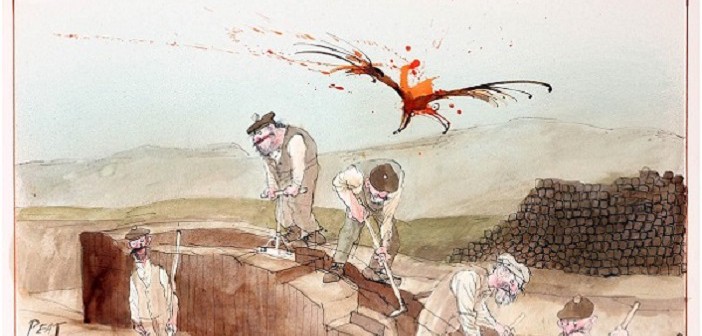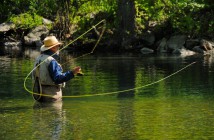Peat is decomposed vegetation that is thousands of years old. It is mostly found in rural parts of Ireland and Scotland where it has been used as an energy source, despite the peat police at the EU who are trying to outlaw its use as a fuel.
Peat needs to be cut from the ground, a bog, as demonstrated in the video below. After it is cut, it needs to dry before it can be used as a fuel. Unlike wood, it burns slowly while delivering a large amount of heat. If you once sat at a peat fire at the Peat Inn in Scotland or at Gus O’Connor’s Pub in Doolin, you can confirm the warmth of burning turf and it’s intoxicating smell.
This is the same peat that gives some whiskies a “peaty” taste.
As the good folks at The Whisky Store write, “The old Scots used peat for heating the pot stills. However that didn’t lead to the smoky taste of the whisky. Only during the drying process of the damp malt over a peat heated fire, the smoke gets into the barley. The difference in the smokiness of the whisky depends on the time the barley is exposed to the biting peat smoke. The drying time of damp malt lies at approximately 30 hours. At Laphroaig about 18 hours of these 30 hours it is dried over peat fires; in contrast at Glengoyne it is dried over non-peat fire. Thus a huge pallet starting from extremely peaty up to whiskies with little smoke flavor develops. There is a special characteristics of malt. Even without peat, the seed develops a little peatiness.”
They continue: “Does the water, which flows through peat moors, have an influence on the smokiness of a whisky? The answer is a clear NO! Peat water contains only a few ppm (parts by million) of peat, which colors the water brown, however it contributes to the smokey taste in no way. Surely, the water is of crucial importance for the quality of whisky, but it does not have an influence on the smokiness. The peat smoke delivers a ten to hundredfold peatyness than the water does.
“The mass production of Scotch over the past 200 years drove up the need for smoky whisky enormously. Particularly the distilleries of the island of Islay produce very smoky whisky. Especially the distilleries Laphroaig, Lagavulin, Caol Ila, Ardbeg and Bowmore.”
Ralph Steadman, whose illustration of turf cutters is above, writes: “Cutting peat is perhaps one of the less common pursuits of ordinary folks and, I would imagine, is practically non-existent among the aristocracy, though I heard a whisper that the occasional Irish lord would take his turn between hangovers, to clear the head… Cutting peat is not an unpleasant experience, if you only have a yard or so to deal with. If you are a serious peat cutter with a real purpose then you purchase about 80 yards of peat bog, about a yard wide, and you cut 18 inch furrows…This amount will keep a fire going for an average heavy Scottish winter, and fill your house with the most delicious, aromatic and musty smell you can imagine.”
Two more things about peat. (Thanks for getting this far.) If you are in my neighborhood, just outside Woodstock, stop by to experience peat burning in the pit, and did I say I’ll be sure to have a 10 year-old Ardbeg, since my current Chieftain’s 17-year-old Ardbeg with a Barolo wine wood finish will likely be gone by then.
You can buy the real thing, not the manufactured stuff, from Irish Flame.
Finally, as someone who has gone digging for the experience, the great Irish poet, Seamus Heaney’s poem Digging is worth a read with a peaty one. He writes, in part:
By God, the old man could handle a spade,
Just like his old man.
My grandfather could cut more turf in a day
Than any other man on Toner’s bog.
Once I carried him milk in a bottle
Corked sloppily with paper. He straightened up
To drink it, then fell to right away
Nicking and slicing neatly, heaving sods
Over his shoulder, digging down and down
For the good turf. Digging.
The cold smell of potato mold, the squelch and slap
Of soggy peat, the curt cuts of an edge
Through living roots awaken in my head.
But I’ve no spade to follow men like them.
Between my finger and my thumb
The squat pen rests.
I’ll dig with it.
For a richer understanding of the poem, check out this analysis.
Sláinte.




